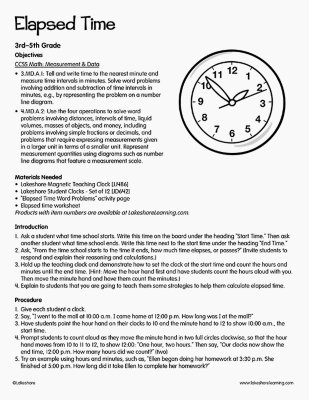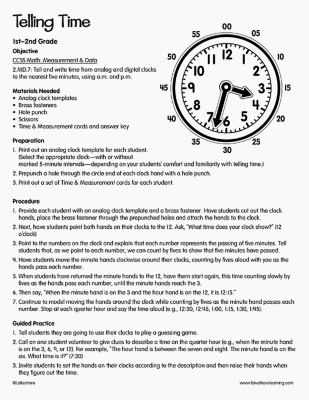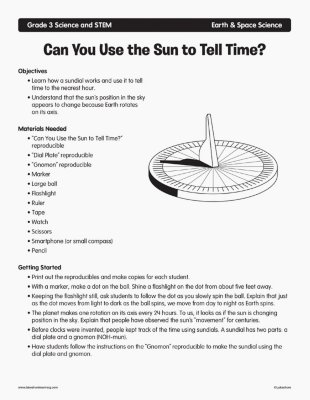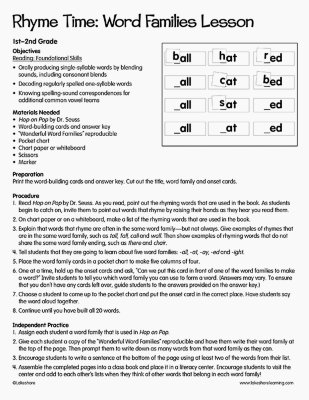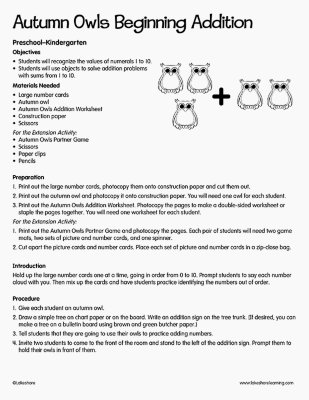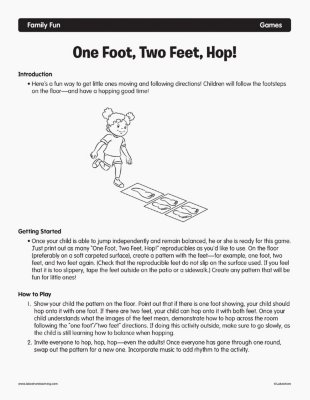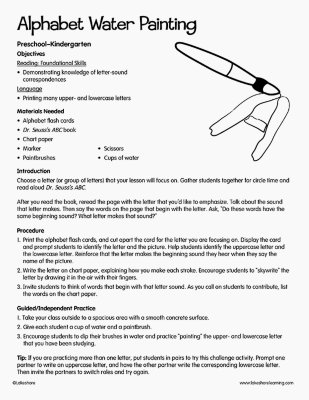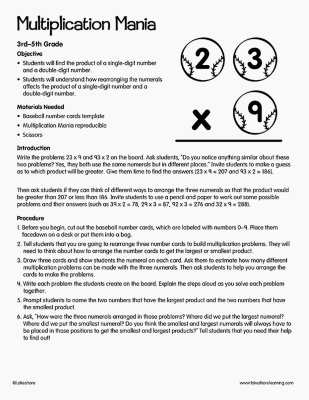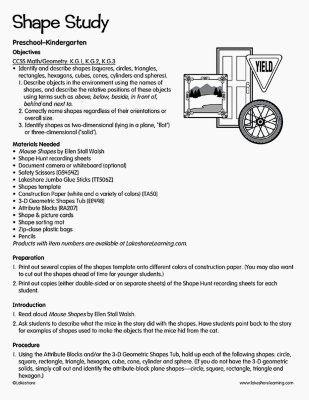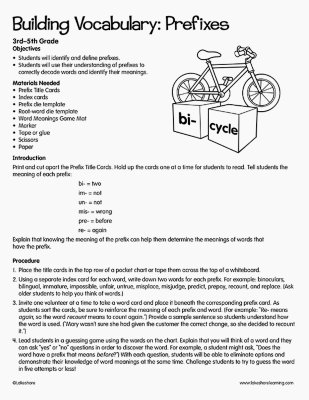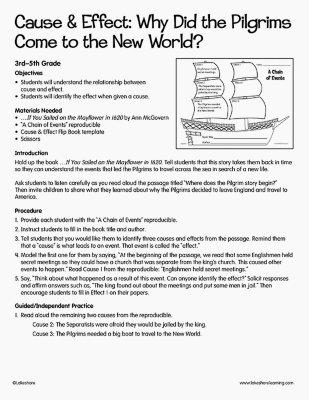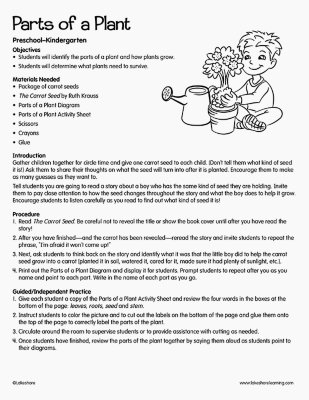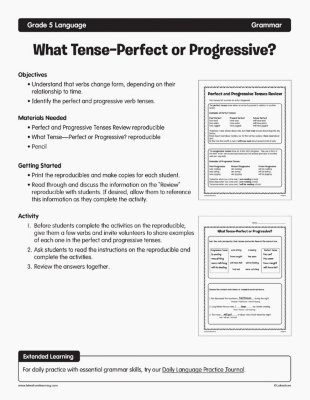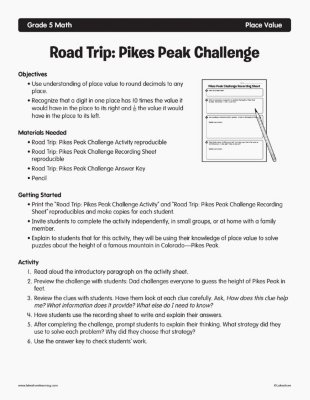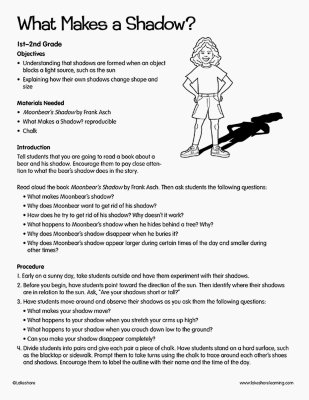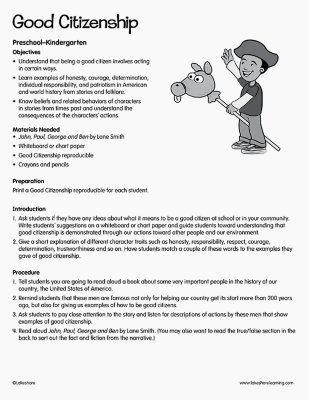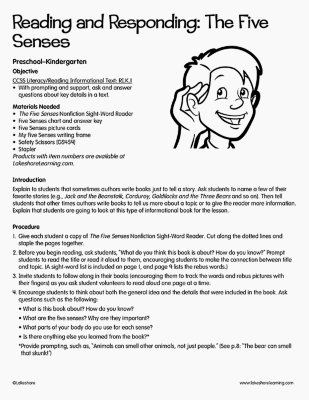Narrow by Grade
Grade
0 results for "time timer" , here are results for "time times"
Elapsed Time
3rd Grade - 4th Grade
Objectives CCSS Math: Measurement & Data 3.MD.A.1: Tell and write time to the nearest minute and measure time intervals in minutes. Solve word problems involving addition and subtraction of time intervals in minutes, e.g., by representing the problem on a number line diagram. 4.MD.A.2: Use the four operations to solve word problems involving distances, intervals of time, liquid volumes, masses of objects, and money, including problems involving simple fractions or decimals, and problems that require expressing measurements given in a larger unit in terms of a smaller unit. Represent measurement quantities using diagrams such as number line diagrams that feature a measurement scale. Materials Needed Lakeshore Magnetic Teaching Clock Lakeshore Student Clocks - Set of 12 “Elapsed Time Word Problems” activity page Elapsed time worksheet Introduction Ask a student what time school starts. Write this time on the board under the heading “Start Time.” Then ask another student what time school ends. Write this time next to the start time under the heading “End Time.” Ask, “From the time school starts to the time it ends, how much time elapses, or passes?” (Invite students to respond and explain their reasoning and calculations.) Hold up the teaching clock and demonstrate how to set the clock at the start time and count the hours and minutes until the end time. (Hint: Move the hour hand first and have students count the hours aloud with you. Then move the minute hand and have them count the minutes.) Explain to students that you are going to teach them some strategies to help them calculate elapsed time.
View Lesson PlanIt’s Time for…
Kindergarten
Objectives Students will identify what time of day certain activities take place. Students will correctly match time to the hour on a digital clock and analog clock. Materials Needed It’s About Time! by Stuart J. Murphy Chart paper/markers or chalkboard/chalk Lakeshore Magnetic Teaching Clock Time match-up card Time match-up game pieces Safety Scissors Introduction Read aloud It’s About Time! by Stuart J. Murphy and explain to students that we do different things at certain times of the day. For example, we might have breakfast at seven o’clock in the morning but get ready for bed at eight o’clock at night.
View Lesson PlanTelling Time
2nd Grade
Objective CCSS Math: Measurement & Data 2.MD.7: Tell and write time from analog and digital clocks to the nearest five minutes, using a.m. and p.m. Materials Needed Analog clock templates Brass fasteners Hole punch Scissors Time & Measurement cards and answer key
View Lesson PlanCan You Use the Sun to Tell Time?
3rd Grade
Objectives
- Learn how a sundial works and use it to tell time to the nearest hour.
- Understand that the sun’s position in the sky appears to change because Earth rotates on its axis.
Tummy Time Tips
Infant
Objectives
• Infants will develop core muscles of the neck, back, and shoulders.
• Infants will build a foundation toward meeting motor milestones, including rolling, crawling, and sitting.
Rhyme Time: Word Families Lesson
1st Grade - 2nd Grade
Objectives Reading: Foundational Skills Orally producing single-syllable words by blending sounds, including consonant blends Decoding regularly spelled one-syllable words Knowing spelling-sound correspondences for additional common vowel teams Materials Needed Hop on Pop by Dr. Seuss Word-building cards and answer key “Wonderful Word Families” reproducible Pocket chart Chart paper or whiteboard Scissors Marker Preparation Print the word-building cards and answer key. Cut out the title, word family and onset cards.
View Lesson PlanAutumn Owls Beginning Addition
Pre-K - Kindergarten
Objectives Counting & Cardinality Understand that the last number name said tells the number of objects counted. The number of objects is the same regardless of their arrangement or the order in which they were counted. Operations & Algebraic Thinking Solve addition and subtraction word problems, and add and subtract within 10, e.g., by using objects or drawings to represent the problem. Materials Needed Large number cards Autumn owl Autumn Owls Addition worksheet Construction paper Scissors Chart paper or whiteboard Bulletin board (optional) Stapler (optional) For the Extension Activity: Autumn Owls Partner Game Scissors Paper clips Pencils Zip-close bag Introduction Hold up the large number cards one at a time, going in order from 0 to 10. Prompt students to say each number aloud with you. Then mix up the cards and have students practice identifying the numbers out of order.
View Lesson PlanOne Foot, Two Feet, Hop!
Toddler
Here’s a fun way to get little ones moving and following directions! Children will follow the footsteps on the floor—and have a hopping good time!
View Lesson PlanCause and Effect
3rd Grade - 4th Grade
Objective CCSS Reading: Informational Text RI.3.3: Describe the relationship between a series of historical events, scientific ideas or concepts, or steps in technical procedures in a text, using language that pertains to time, sequence, and cause/effect. Materials Needed “The Earthquake that Changed Earth” nonfiction reading selection “The Earthquake that Changed Earth” graphic organizer and sample graphic organizer Cause & Effect Flip Book template Scissors Pencils or markers A copy of any other nonfiction text
View Lesson PlanAlphabet Water Painting
Pre-K - Kindergarten
Objectives Reading: Foundational Skills Demonstrating knowledge of letter-sound correspondences Language Printing many upper- and lowercase letters Materials Needed Alphabet flash cards Dr. Seuss’s ABC book Chart paper Marker Paintbrushes Cups of water Scissors Introduction Choose a letter (or group of letters) that your lesson will focus on. Gather students together for circle time and read aloud Dr. Seuss’s ABC. After you read the book, reread the page with the letter that you’d like to emphasize. Talk about the sound that letter makes. Then say the words on the page that begin with the letter. Ask, “Do these words have the same beginning sound? What letter makes that sound?”
View Lesson PlanClose Reading and Text Features
3rd Grade - 4th Grade
Objectives CCSS Reading: Informational Text RI.3.7: Use information gained from illustrations (e.g., maps, photographs) and the words in a text to demonstrate understanding of the text (e.g., where, when, why, and how key events occur). RI.4.7: Interpret information presented visually, orally, or quantitatively (e.g., in charts, graphs, diagrams, time lines, animations, or interactive elements on Web pages) and explain how the information contributes to an understanding of the text in which it appears. Materials Needed “Three Cheers for Engineers!” reading passage Paper and pencils Introduction Provide students with a copy of the “Three Cheers for Engineers!” reading passage. Tell students, “Today we are going to read a passage titled, “Three Cheers for Engineers!” One practice of good readers is that they pay close attention to the text. As we read, I want you to think about the meaning of the text, the words that are used and other features on the page that are used to help interpret the text.”
View Lesson PlanMultiplication Mania
3rd Grade
Objectives Students will find the product of a single-digit number and a double-digit number. Students will understand how rearranging the numerals affects the product of a single-digit number and a double-digit number. Materials Needed Baseball number cards template Multiplication Mania reproducible Scissors Introduction Write the problems 23 x 9 and 93 x 2 on the board. Ask students, “Do you notice anything similar about these two problems? Yes, they both use the same numerals but in different places.” Invite students to make a guess as to which product will be greater. Give them time to find the answers (23 x 9 = 207 and 93 x 2 = 186). Then ask students if they can think of different ways to arrange the three numerals so that the product would be greater than 207 or less than 186. Invite students to use a pencil and paper to work out some possible problems and their answers (such as 39 x 2 = 78, 29 x 3 = 87, 92 x 3 = 276 and 32 x 9 = 288).
View Lesson PlanShape Study
Kindergarten
Objectives CCSS Math/Geometry: K.G.1, K.G.2, K.G.3 Identify and describe shapes (squares, circles, triangles, rectangles, hexagons, cubes, cones, cylinders and spheres). Describe objects in the environment using the names of shapes, and describe the relative positions of these objects using terms such as above, below, beside, in front of, behind and next to. Correctly name shapes regardless of their orientations or overall size. Identify shapes as two-dimensional (lying in a plane, “flat”) or three-dimensional (“solid”). Materials Needed Mouse Shapes by Ellen Stoll Walsh Shape Hunt recording sheets Document camera or whiteboard (optional) Safety Scissors Lakeshore Jumbo Glue Sticks Shapes template Construction Paper (white and a variety of colors) 3-D Geometric Shapes Tub Attribute Blocks Shape & picture cards Shape sorting mat Zip-close plastic bags Pencils Preparation Print out several copies of the shapes template onto different colors of construction paper. (You may also want to cut out the shapes ahead of time for younger students.) Print out copies (either double-sided or on separate sheets) of the Shape Hunt recording sheets for each student. Introduction Read aloud Mouse Shapes by Ellen Stoll Walsh. Ask students to describe what the mice in the story did with the shapes. Have students point back to the story for examples of shapes used to make the objects that the mice hid from the cat.
View Lesson PlanBuilding Vocabulary: Prefixes
3rd Grade - 4th Grade
Objectives Identifying and knowing the meaning of the most common prefixes and derivational suffixes Determining the meaning of the new word formed when a known affix is added to a known word Using common, grade-appropriate Greek and Latin affixes and roots as clues to the meaning of a word Materials Needed Prefix title cards Index cards Prefix die template Root-word die template Word meanings game mat Marker Tape or glue Scissors Paper Pocket chart or whiteboard Introduction Print and cut apart the prefix title cards. Hold up the cards one at a time for students to read. Tell students the meaning of each prefix: bi- = two im- = not un- = not mis- = wrong pre- = before re- = again Explain that knowing the meaning of the prefix can help them determine the meanings of words that have the prefix.
View Lesson PlanCause & Effect: Why Did the Pilgrims Come to the New World?
3rd Grade
Objectives Students will understand the relationship between cause and effect. Students will identify the effect when given a cause. Materials Needed …If You Sailed on the Mayflower in 1620 by Ann McGovern “A Chain of Events” reproducible Cause & Effect Flip Book template Scissors Introduction Hold up the book …If You Sailed on the Mayflower in 1620. Tell students that this story takes them back in time so they can understand the events that led the Pilgrims to travel across the sea in search of a new life. Ask students to listen carefully as you read aloud the passage titled “Where does the Pilgrim story begin?” Then invite children to share what they learned about why the Pilgrims decided to leave England and travel to America.
View Lesson PlanParts of a Plant
Kindergarten
Objectives Students will identify the parts of a plant and how plants grow. Students will determine what plants need to survive. Materials Needed Package of carrot seeds The Carrot Seed by Ruth Krauss Parts of a Plant Diagram Parts of a Plant Activity Sheet Scissors Crayons Glue Introduction Gather children together for circle time and give one carrot seed to each child. (Don’t tell them what kind of seed it is!) Ask them to share their thoughts on what the seed will turn into after it is planted. Encourage them to make as many guesses as they want to. Tell students you are going to read a story about a boy who has the same kind of seed they are holding. Invite them to pay close attention to how the seed changes throughout the story and what the boy does to help it grow. Encourage students to listen carefully as you read to find out what kind of seed it is!
View Lesson PlanWhat Tense—Perfect or Progressive?
5th Grade
Objectives
- Understand that verbs change form, depending on their relationship to time.
- Identify the perfect and progressive verb tenses.
Road Trip: Pikes Peak Challenge
5th Grade
Objectives
- Use understanding of place value to round decimals to any place.
- Recognize that a digit in one place has 10 times the value it would have in the place to its right and 1/10 the value it would have in the place to its left.
What Makes a Shadow?
1st Grade
Objectives Understanding that shadows are formed when an object blocks a light source, such as the sun Explaining how their own shadows change shape and size Materials Needed Moonbear’s Shadow by Frank Asch What Makes a Shadow? reproducible Chalk Introduction Tell students that you are going to read a book about a bear and his shadow. Encourage them to pay close attention to what the bear’s shadow does in the story. Read aloud the book Moonbear’s Shadow by Frank Asch. Then ask students the following questions: What makes Moonbear’s shadow? Why does Moonbear want to get rid of his shadow? How does he try to get rid of his shadow? Why doesn’t it work? What happens to Moonbear’s shadow when he hides behind a tree? Why? Why does Moonbear’s shadow disappear when he buries it? Why does Moonbear’s shadow appear larger during certain times of the day and smaller during other times?
View Lesson PlanGood Citizenship
Pre-K - 1st Grade
Objectives Understand that being a good citizen involves acting in certain ways. Learn examples of honesty, courage, determination, individual responsibility, and patriotism in American and world history from stories and folklore. Know beliefs and related behaviors of characters in stories from times past and understand the consequences of the characters’ actions. Materials Needed John, Paul, George and Ben by Lane Smith Whiteboard or chart paper Good Citizenship reproducible Crayons and pencils Introduction Ask students if they have any ideas about what it means to be a good citizen at school or in your community. Write students’ suggestions on a whiteboard or chart paper and guide students toward understanding that good citizenship is demonstrated through our actions toward other people and our environment. Give a short explanation of different character traits such as honesty, responsibility, respect, courage, determination, trustworthiness and so on. Have students match a couple of these words to the examples they gave of good citizenship.
View Lesson PlanReading and Responding: The Five Senses
Kindergarten
Objective CCSS Literacy/Reading Informational Text: RI.K.1. With prompting and support, ask and answer questions about key details in a text. Materials Needed The Five Senses Lakeshore Nonfiction Sight-Word Reader Five Senses chart and answer key Five Senses picture cards My Five Senses writing frame Safety Scissors Stapler Introduction Explain to students that sometimes authors write books just to tell a story. Ask students to name a few of their favorite stories (e.g., Jack and the Beanstalk, Corduroy, Goldilocks and the Three Bears and so on). Then tell students that other times authors write books to tell us more about a topic or to give the reader more information. Explain that students are going to look at this type of informational book for the lesson.
View Lesson Plan